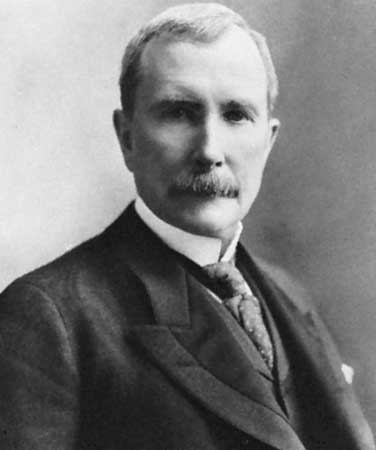
John D. Rockefeller and his associates were making a concerted effort to control the entire field of medicine in America. During the 1890s, Rockefeller interests in medical education and "scientific medicine" were spearheaded by Frederick T. Gates, John D. Rockefeller's investment manager. 1901 saw the founding of the Rockefeller Institute for Medical Research with $60,000,000 to "advance and disseminate knowledge of the nature, causes, treatment and prevention of disease." 1902, Rockefeller's General Education Board was founded with a mission to annihilate the causes of racial discords. This agenda was clarified two years later with the publication of John D. Rockefeller's Occasional Letter No. 1 in which he detailed his plans to mold Americans to his concept of "perfect human nature." This, he claimed, might best be accomplished by destroying parental influence, traditions and customs, while reducing national intelligence levels.
By 1907, medical education had been mostly monopolized by the Rockefeller consortium. That year, the American Medical Association (AMA) advanced its medical education rating system effectively eliminating, by 1918, approximately 600 of the initial 650 medical schools.
Henry S. Pritchett, the president of the Carnegie Foundation, approached the AMA and simply offered to take over the entire project. The minutes for the meeting of the AMA's Council on Medical Education held in New York in December of 1908 tell the story:
At one o'clock an informal conference was held with President Pritchett and Mr. Abraham Flexner of the Carnegie Foundation. Mr. Pritchett had already expressed by correspondence the willingness of the Foundation to cooperate with the Council in investigating the medical schools. He now explained that the Foundation was to investigate all the professions: law, medicine, and theology . . .
He agreed with the opinion previously expressed by the members of the Council that while the Foundation would be guided very largely by the Council's investigation, to avoid the usual claims of partiality no more mention should be made in the report of the Council than any other source of information. The report would therefore be, and have the weight of, a disinterested body, which would then be published far and wide. It would do much to develop public opinion.
Here was the classical "philanthropic formula" at work again. Have others pay a major portion of the bill (the AMA had already done most of the work. The total Carnegie investment was only $ 10,000), reap a large bonus from public opinion (isn't it wonderful that these men are taking an interest in upgrading medical education!), and gain an opportunity to control a large and vital sphere of American life.
This is how that control came about.
The Flexner Report, as it was called, was published in 1910. As anticipated, it was "published far and wide," and it did "do much to develop public opinion." The report quite correctly pointed out the inadequacies of medical education at the time. No one could take exception with that. It also proposed a wide range of sweeping changes, most of which were entirely sound. No one could take exception with those, either. The alert researcher will note, however, the recommendations emphatically included the strengthening of courses in pharmacology and the addition of research departments at all "qualified" medical schools.
After Abraham Flexner completed his report, he became one of the three most influential men in American medicine. The other two were his brother, Dr. Simon Flexner of the Rockefeller Institute and Dr. William Welch of Johns Hopkins Medical School and of the Rockefeller Institute. According to Hinsey, these men, acting as "a triumvirate":
. . .were not only involved in the awarding of grants for the Rockefeller Foundation, but they were counselors to heads of institutions, to lay board members, to members of staffs of medical schools and universities in the United States and abroad. They served as sounding boards, as stimulators of ideas and programs, as mediators in situations of difficulty.
The foundations captured control of the apex of the pyramid of medical education when they were able to place their own people onto the boards of the various schools and into key administrative positions. The middle of the pyramid was secured by the Association of American Medical Colleges which set standards and unified the curricula. The base of the pyramid, however, was not consolidated until they finally were able to select the teachers themselves. Consequently, a major portion of foundation activity always has been directed toward what generally is called "academic medicine." Since 1913, the foundations have completely preempted this field. The Commonwealth Fund reports a half a million dollars in one year alone appropriated for this purpose, while the Rockefeller Foundation boasts of over twenty thousand fellowships and scholarships for the training of medical instructors.
And so it has come to pass that the teaching staffs of all our medical schools are a very special breed. In the selection and training process, heavy emphasis always has been put on finding individuals who, because of temperament or special interest, have been attracted by the field of research, and especially by research in pharmacology. This has resulted in loading the staffs of our medical schools with men and women who, by preference and by training, are ideal propagators of the drug-oriented science that has come to dominate American medicine. And the irony of it is that neither they nor their students are even remotely aware that they are products of a rigid selection process geared to hidden commercial objectives. So thorough is their insulation from this fact that, even when exposed to the obvious truth, very few are capable of accepting it, for to do so would be a tremendous blow to their professional pride.








The Dulles brothers were the perpetrators and protectors of all evil in 20th century America.
ReplyDeleteTim Fleming
www.eloquentbooks.com/MurderOfAnAmericanNazi.html
http://leftlooking.blogspot.com
www.AuthorsWebTV.com